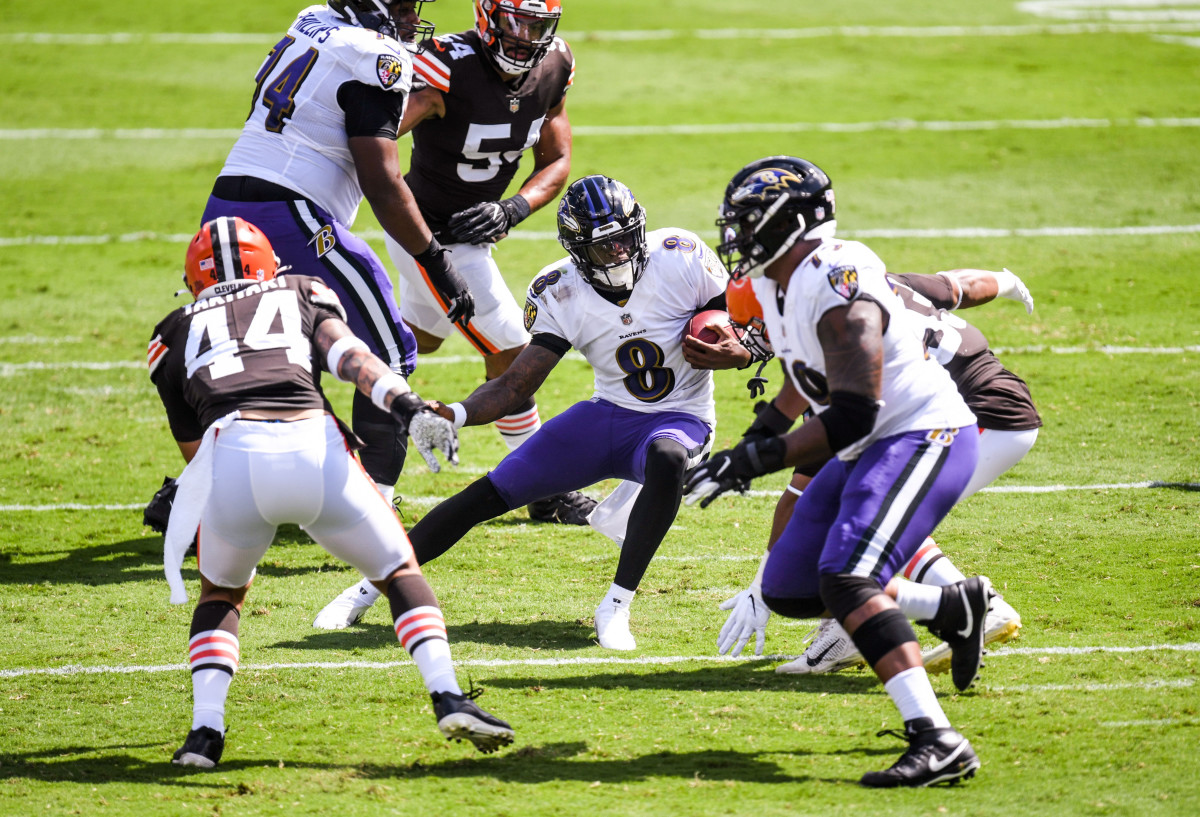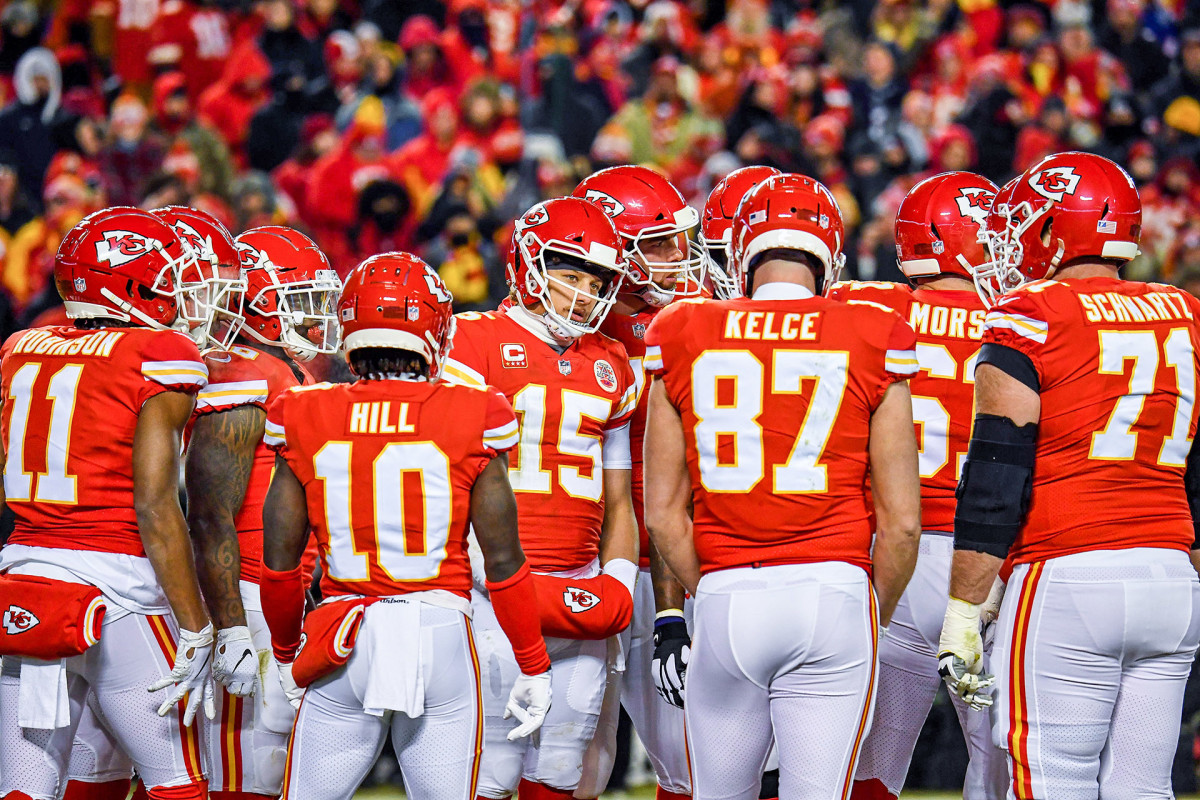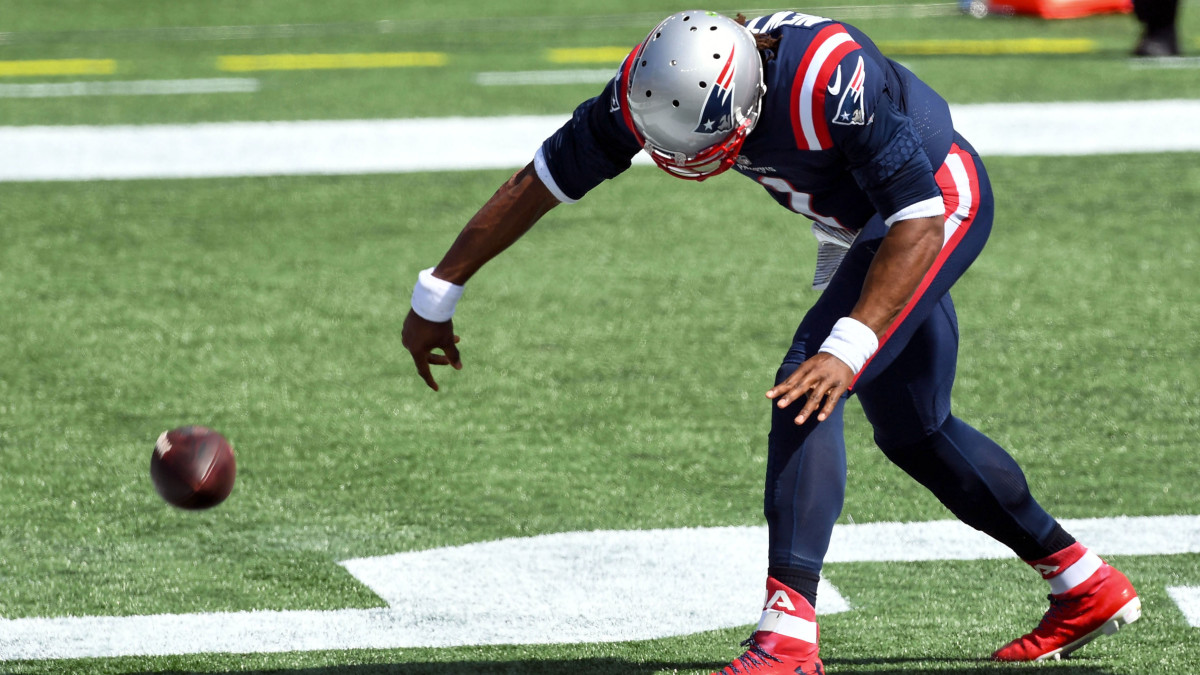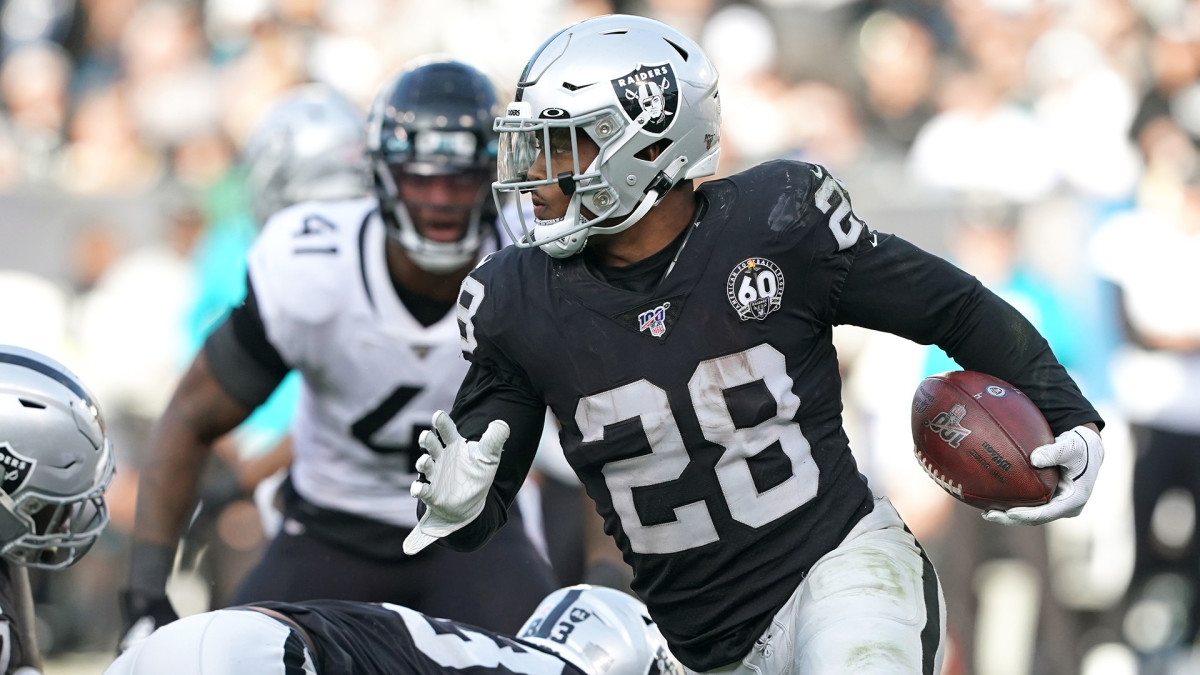Revisiting Lamar Jackson and Patrick Mahomes as Draft Prospects Before Their MNF Showdown
The Ravens weren’t going to do a thing to tip their interest in Lamar Jackson. In fact, much was done to cover it up in 2018—they even brought Louisville’s Heisman winner to Baltimore on the last day predraft visits were allowed by NFL rules, in hopes that the summit would fly under the radar and other teams wouldn’t get to ask Jackson about his experience there. Which, in its own way, was a tell on the reality of the situation.
Conversely, within a small group inside the building, the work on Jackson was intense.
The reason why was right there in plain sight for anyone with a cable subscription in the autumns of 2015 and ’16. The kid brought an undeniable playmaking ability to the table. He’d thrown for 7,203 yards and 57 touchdowns, and rushed for 3,172 yards and another 41 touchdowns in his final two seasons as a Cardinal, winning the Heisman as a sophomore, and besting his ’15 numbers as a junior.
The plan for inserting Jackson into an NFL offense had to be complex. Deploying him in a conventional offense would be like playing Deion Sanders in zone, or dropping J.J. Watt into coverage. Could you do it? Maybe. But you wouldn’t get the most out of him playing that way.
So John Harbaugh gathered then OC Marty Mornhinweg, QBs coach James Urban and tight ends coach Greg Roman that April, and asked them for a detailed plan to answer the question: If we draft Lamar Jackson, how will we use him?

Long story short, that’s how the post–Joe Flacco Baltimore offense was born. Mornhinweg, Urban and Roman assembled a plan; the coaches presented it to GM Ozzie Newsome, GM to be Eric DeCosta and the scouts; and Baltimore traded back into the first round to get him. Then, when Flacco got hurt during Jackson’s supposed “redshirt” year, that plan was put into motion ahead of schedule. An MVP award later, the rest is history.
On Monday, the NFL will get a reminder of how many people missed on all this.
That Patrick Mahomes and Lamar Jackson were first-round picks shows that the league did, indeed, recognize the off-the-charts production of the two quarterbacks as collegians. That Mahomes went 10th and Jackson 32nd, on the other hand, shows us something else: Some franchises have moved their organizations forward through a time of a lot of change in football, and others haven’t.
And, really, that can be boiled down to that simple thought Harbaugh had that April: Here’s a great player. How would we use him?
Since, the Ravens have shown everyone how.
***
We’re back for Week 3, and in this week’s GamePlan we’re bringing you …
• Power rankings!
• Why New England should extend Cam Newton … now.
• How the Raiders might be winning the Khalil Mack trade.
But we’re starting with a look at the MVP quarterbacks facing off Monday night, by taking a look back.
***
I was talking to an exec with an AFC team on Wednesday who’d checked out our podcast with Chiefs GM Brett Veach over the summer and heard Veach reference watching the 2015 Texas Bowl as the moment he got religion on Mahomes. After listening, this veteran evaluator decided to pull up that game—LSU vs. Texas Tech—as an exercise, to see what he might’ve missed ahead of the 2017 draft.
It was a lot, as it turned out.
“It was a freak show—he was ripping the ball, and I can see why you’d watch that and say, How’d this dude fall to 10?” said the exec. “You got Deion Jones, Tre’Davious White, Jamal Adams, [Kevin] Toliver running around. LSU had so many dudes. And it’s him against the world. Running away from the rush. Throwing against his body. He’s got this cannon of an arm, and he’s holding them in the game by himself.”
And then, the exec snapped back to what the reality of the situation was at the time.
“You’d had to be a big-balls mother------ to take him with, say, the fourth pick if you were Jacksonville at the time—balls like grapefruits,” he continued. “Kansas City could do it. They had Alex [Smith]. They had the infrastructure to develop him. They were already winning. Great situation. Great call by them. All the credit to Veach for seeing what a lot of us didn’t.”
The predraft cases for Jackson and Mahomes were different, to be sure.
The issue with Mahomes was a free-wheeling style that clouded his evaluation, a daring looseness with the ball that led some to believe he’d be a turnover waiting to happen in the pros, and an offense that routinely churned out cartoonish passing numbers, even with average quarterbacks at the helm. With Jackson, it was how reliant Louisville was on his legs, and whether his frame—he’s not built like Cam Newton or Tim Tebow—would hold up if he had to run that much in the NFL, plus his ability to pick up a pro offense.
That stuff is right there in my notes from the April of their draft years. On Mahomes, one AFC QBs coach said to me, “He has the best wrist of any of them, he flicks the ball, puts it wherever he wants it. And he’s smart enough. That system’s different obviously, but he gets their system and can learn what he doesn’t know. Now, there’s gonna be a major learning curve.” And on Jackson, an AFC OC said, “There’s obviously a lot of projection there on how much he can or can’t improve. He’s a great athlete. But you’re drafting a quarterback.”
Which brings us to the one big similarity in their predraft cases: The teams that took them were focused not on what Mahomes and Jackson couldn’t do, but what they could do.
***
To be fair, there were built-in advantages Baltimore and Kansas City had ahead of drafting those guys. Like the exec above said, it would have taken some stomach to draft one of the two into disjointed situations without the infrastructure to develop them correctly.
Veach knew he’d be dropping Mahomes off to Andy Reid, and onto a roster where he wouldn’t need to play right away and one that would support him when that time came, with a veteran line and explosive set of skill players. Likewise, Newsome knew Harbaugh had a desire to play more gap scheme in the run game and building around an athletic QB would help the coach do it. That’s why Harbaugh hired Roman, who also happened to be perfect for Jackson.
But that Mahomes and Jackson have benefited from all that doesn’t mean there isn’t a lot to learn from what the NFL struck out with on them—or that those guys wouldn’t have succeeded absent the really good circumstances they arrived in the NFL under.
“I think the biggest thing to me is there are no perfect quarterbacks,” said one AFC GM. “You’re going to be dealing with some weaknesses, and some things they do really well. But really, none of them are exceptional in every category. Other than maybe Andrew Luck in 2012, no one checks every box. And the bottom line is you’ll go broke looking for the perfect prospect.”
Obviously, that was part of it for the Chiefs and Ravens. The Chiefs felt like they could clean up Mahomes’s fundamentals, and that he could learn Reid’s system—so neither deficiency would be nearly enough to give them pause. And the Ravens did enough work on Jackson to feel confident that his playmaking ability was worth gambling on, and that Jackson himself had the tools to improve as a passer and the head to adjust to the pro game.
Years later, those bets have paid off handsomely.
But there was also an open-mindedness applied here, on where the game is going. These guys weren’t playing in traditional pro offenses in college, and so rather than trying to shoehorn them into those sorts of schemes, their teams met them halfway. Reid applied some Air Raid concepts. Harbaugh and his staff weren’t shy about implementing option looks. And that made it so Mahomes and Jackson could hit the ground running.
The fact is, not everyone is willing to do these things—and not all players are worth overturning the apple cart for. Mahomes and Jackson clearly were.
“You’re really asking yourself simple questions,” said another AFC exec. “Do we think this is a great player? Yes. Can we build our offense to fit him? Yes. It’s no different than how you look at other positions. If we took Aaron Donald in 2014, we can’t play our defense the way we do and expect him to be as productive. We have to set it up for him. That’s why so many teams passed on Donald. Honestly, it’s the exact same thing.”
“Not every coach is willing to do what Harbaugh and Roman were willing to do,” said a second AFC GM. “That’s part of it. And I think more coaches are getting there, and being more open-minded to looking at college concepts that do work for these guys. Instead of saying, I run the West Coast offense, and this guy must fit the system, I think now you gotta adapt to what you have.”
Truth is, this isn’t all that new, either. Back in 2012, Washington did it with Robert Griffin III, importing the Baylor offense to great results, with the idea being that playing that way would buy the then-raw Griffin time to develop what he didn’t have, so by the time teams caught up with what they were doing, the quarterback and offense would’ve grown an array of counterpunches.
A bad injury and internal politics too complex to discuss in full here wound up firebombing that plan in late 2012 and through 2013. But Baltimore and Kansas City have proved in the time since that it very much can work.
“Kyle and Mike Shanahan had figured it out the whole time,” joked the first AFC exec.
The problem was, postinjury, it took Griffin a little too long.
***
And then there’s that last element—focusing on who the player is as a person.
Last year, ex-Louisville coach Bobby Petrino told me this story about Jackson’s first college practice. Petrino was standing with his AD, Tom Jurich, as Jackson ran the scout team, and on one play, the quarterback took the snap out of the shotgun, stood flat-footed and threw over the defense for a touchdown. Petrino leaned over to Jurich and said, We got a real one.
“The way he snapped his wrist and threw that post for a touchdown, it was something. If you work with him, you see,” Petrino said. “And that’s the one thing I really respect about the Ravens. They were the only group that came in and spent time with me and my staff to find this stuff out. They spent two hours with me—the quarterbacks coach and head of scouting were there. ... I was surprised more people didn’t want to talk to me about Lamar.”
The Ravens figured out who Jackson was, while others were put off by the fact that he didn’t immediately command every room he walked into. Just the same, the Chiefs dug into Mahomes and saw what others did, but maybe didn’t prioritize enough.
And who Jackson and Mahomes are wound up being vitally important to where they were going—because that dictated their willingness to fix the imperfections in their games, which would determine how sustainable they’d be in the NFL.
“There have been plenty of guys that were dynamic players that haven’t panned out,” said our second AFC exec. “One thing that stands out about those two was their competitiveness, how they are as teammates. Both were smart football players on the field, can throw from different platforms and arm angles. But their competitiveness and desire to win is what pushes them. … They were confident, but it’s not like they were these outward Alphas. They weren’t trying too hard. They were just good dudes and they loved ball.”
And, the exec continued, that would manifest in the pros in guys who were “always gonna be driven to improve. You tell him to improve, and he’s gonna do it. Both those guys. Joe Burrow’s the same way. Highly competitive, highly driven and highly coachable.”
So, really, you can distill all this to just a few things. One, these guys were great players all along. Two, they were genuinely competitive and driven, which would be a good place to start as they worked to improve what wasn’t there. Three, they went to teams that didn’t want them to be anything but the best versions of themselves.
Two and a half years ago, Harbaugh and his coaches saw all of that, and figured that they could take care of the rest.
I’d say they were right.
***

POWER RANKINGS
I think I need to give you a 1–2 matchup this week. The good news is I have to change nothing from last week to do it.
1) Kansas City Chiefs (2–0): I think the Chargers are a really good team. And that game Sunday still gave you the feeling that Kansas City can flip a switch when it needs to, to get itself out of trouble. Which is a nice thing to have.
2) Baltimore Ravens (2–0): Based on how the Ravens have played through two weeks, I’d have no qualms with anyone putting them first. The margin here was razor thin.
3) Seattle Seahawks (2–0): The defense needs work, but Russell Wilson is playing like a man on a mission—to prove to everyone he’s the best player in football. And the offense in general looked balanced and explosive against New England.
4) Green Bay Packers (2–0): I was tempted to put them third. They’ve broken 40 points off two weeks in a row, and the defense came on strong against Detroit. They’ve drafted really well under GM Brian Gutekunst, and it’s showing.
5) Buffalo Bills (2–0): It was tough to pick a fifth team this week, but give Buffalo credit for taking care of business in their division. If the strides we’ve seen from Josh Allen prove to be real, and the defense picks up the pace a little, this could be a 12-win type of team.
***

THE BIG QUESTION
Should the Patriots extend Cam Newton?
I’ve gotten this question a lot the last week. My answer might surprise you—it’s a very resounding yes. And by yes, I don’t mean, yes, in a couple of months. I mean, yes, right now. I’ll try to show you why this isn’t an overreaction by giving you three reasons that I think would be tough to argue with.
If Newton keeps playing well, you’ll lose leverage. After being dumped by Carolina, it stands to reason that Newton wouldn’t mind knowing where he’s spending the next few years. And by paying him now, you’d be mitigating 14 games of injury risk for him, which would give him reason to give you a discount. If you wait until midseason, and this continues, the dynamic for a player like him inevitably moves from I should take the injury protection now to I only have to make it through X number of games to get to free agency.
It’ll help you manage your cap with cap uncertainty looming. In doing a deal now, you’re folding in his discounted 2020 financials with future money. So let’s say you give him a Ryan Tannehill extension—four years, $118 million. That’s $29.5 million per year. But if you add the $5 million or so he’ll get this year, you’re now at $123 million over five. That’s less than $25 million per year, and you can play with the numbers to make it work however you want cap-wise.
As such, you can dump cap dollars into this year. With a cap dip likely coming in 2021, this is important. At one point, the Patriots had the least cap space in the NFL. Now, they have the fifth-most, at $24.52 million. So they could take a fairly sizable hit now, to manage what’s coming down the line. And yes, you can roll cap space over. But relying on that to absorb a massive free-agent deal with Newton would be infinitely more complicated than getting some certainty on the situation now.
It would likely give you more flexibility down the line. Everyone knows NFL contracts are worth only what’s guaranteed, and just about every one of them isn’t worth much before three years. Assuming it’d take a three-year commitment on a longer deal to get Cam signed, why not start that clock now? Doing the deal today would likely mean marrying yourself to Newton through 2022, which is just two more years from where you are now. And that means you’d maintain a fair amount of flexibility in the bargain.
Best case for the Patriots, Newton can be their franchise QB going forward. But even if he’s not, can’t he be what Alex Smith was for Kansas City and buy the Patriots time to find a twentysomething they’re absolutely smitten with? And if that’s the low-end of the equation here, barring significant injury, wouldn’t they be O.K. with that?
I know I would be. I also know it’s a lot better than stumbling around in the quarterback wilderness looking for the next one.
***

WHAT NO ONE IS TALKING ABOUT
How the Raiders might’ve gotten the best of the Khalil Mack deal.
Do I know that definitively yet? No, I do not. Is it on the table? It sure is. Here’s what the Raiders’ return in the 2018 megadeal was harvested.
• 2019 first-round pick: Alabama RB Josh Jacobs.
• 2019 sixth-round pick: Used as capital to land LSU TE Foster Moreau.
• 2020 first-round pick: Ohio State CB Damon Arnette.
• 2020 third-round pick: South Carolina WR Bryan Edwards.
Jacobs, Arnette and Edwards all started and played the great majority of snaps on their sides of the ball as Vegas stunned the Saints on Monday night, and Moreau wound up playing more than Jason Witten did as the Raiders’ second tight end—even making a crucial 31-yard catch on the team’s go-ahead drive in the third quarter.
Those four guys’ combined cap number for 2020 ($6.8 million) is nearly $20 million less than Mack’s cap charge in Chicago ($26.6 million). Those four Raiders are 21 (Edwards), 22 (Jacobs), 23 (Moreau) and 24 (Arnette) years old. Mack turns 30 in February.
Now, the Bears did get picks back in the deal (those became TE Cole Kmet and OL Arlington Hambright), and there’s no arguing what Mack’s meant over two years there as Matt Nagy has established his program.
So I don’t think the Bears would do anything differently. But along those lines, I know the Raiders don’t have regrets either. And yes, part of this was about the amount of cash they were willing to shell out at the time (two years before the windfall of the move to Vegas). But they also had to ask themselves this question: How quickly can we contend, what will Mack have left then and will we still want to be paying the freight when we get there?
The answer then was that it would take a while for the Raiders to build, and Mack might not be worth the price tag once they got there. And that answer stands up today, I’d say.
And that’s nothing against Mack whatsoever. It’s just the reality of the situation.
***
THE FINAL WORD
We’re in the midst of a rough patch in the Thursday Night Football schedule, but I’m strangely excited to get a full look at Gardner Minshew tonight. Also, after Ryan Fitzpatrick made that comment about patchy facial hair, I hope Minshew comes out tonight sporting a full beard (and that’s coming from someone with … patchy facial hair).
